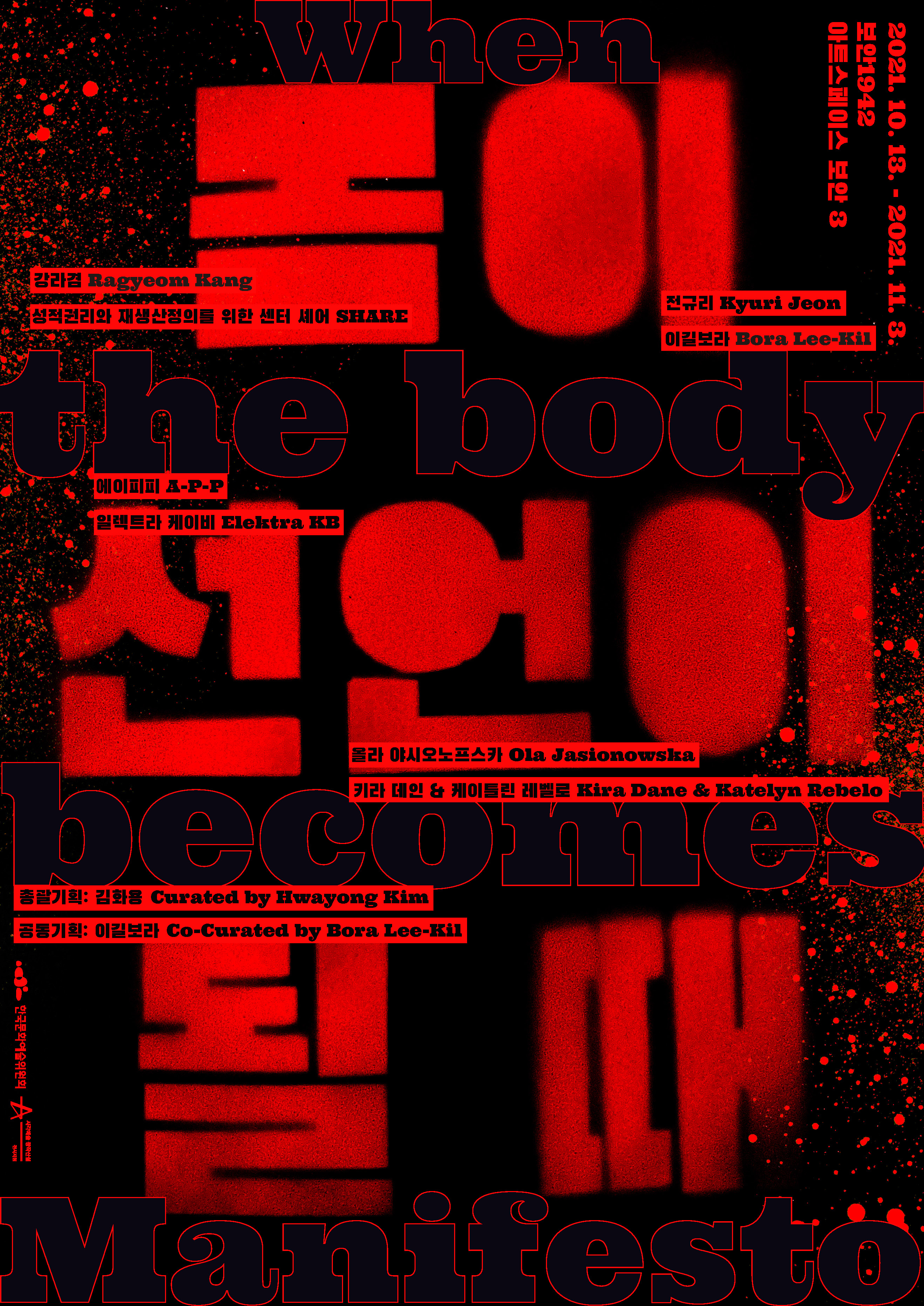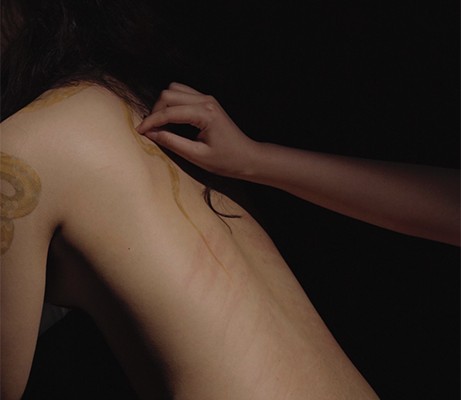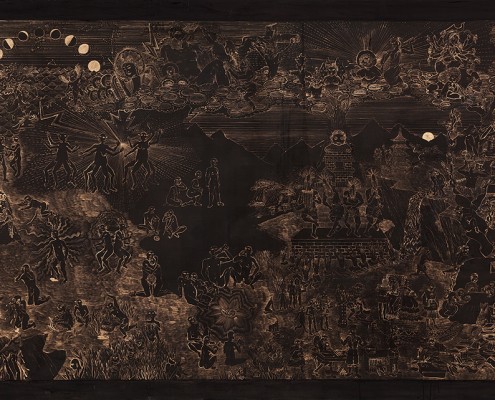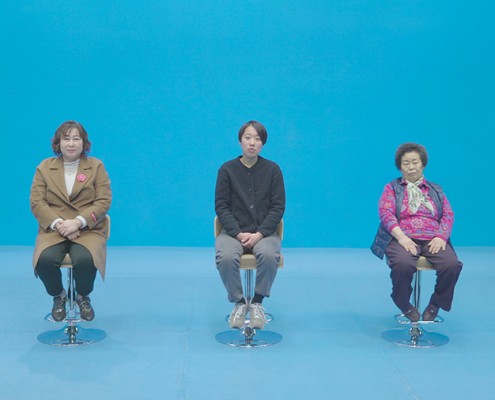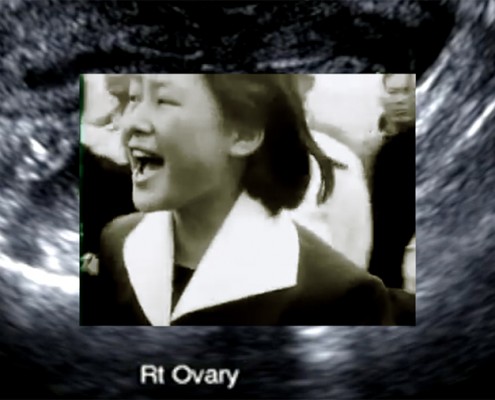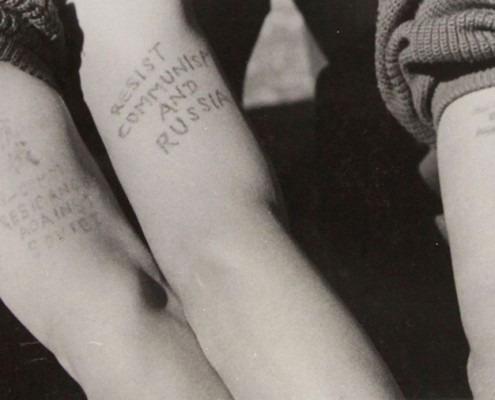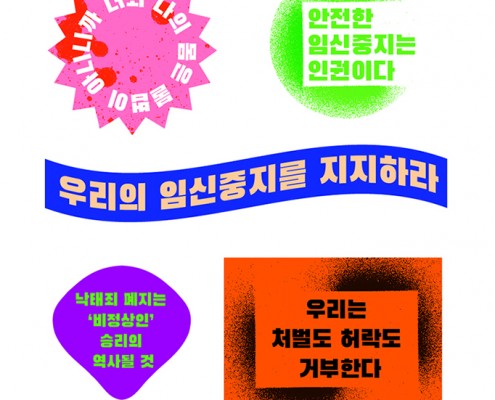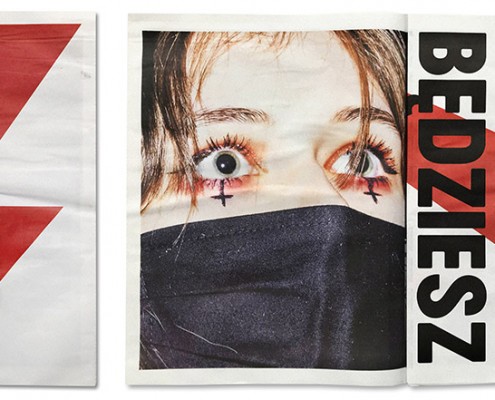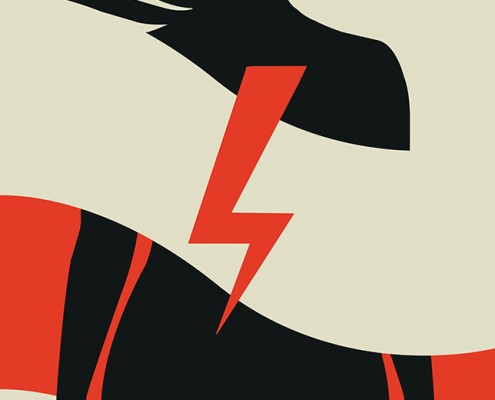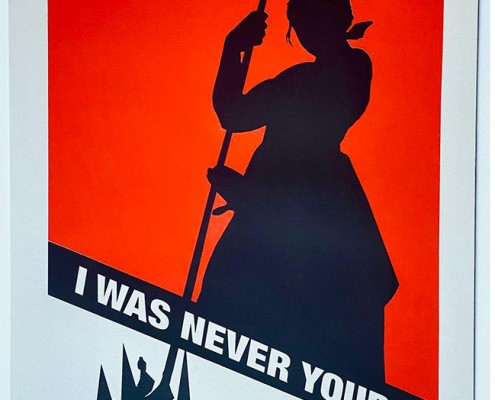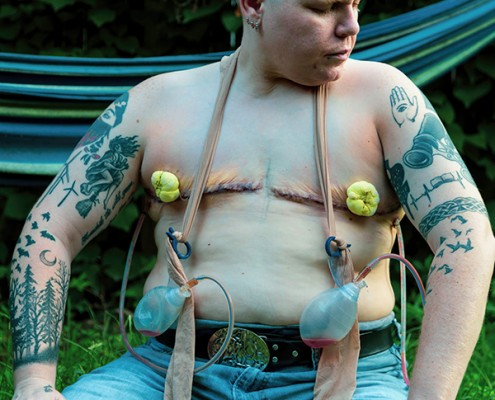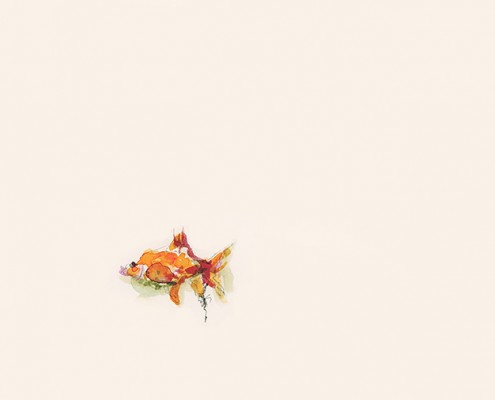몸이 선언이 될 때
- 일시: 2021. 10. 13 ~ 11. 03
- 장소: 아트스페이스 보안3 *전시 주제와 관련된 출판물 및 작가의 자료를 보안책방(신관 2층)에서 이어서 관람하실 수 있습니다.
- 참여작가: 강라겸, 이길보라, 전규리, 성적권리와 재생산정의를 위한 센터 셰어 SHARE (나영정 안팎 이은진/ 디자인 협업 여혜진), 에이피피 (거리 투쟁의 아카이브), 올라 야시오노프스카, 일렉트라 베이키, 키라 데인 & 케이틀린 레벨로
- 기획: 김화용
- 운영시간: 12:00 ~ 18:00
- 월요일 휴관
- 입장료 무료
When the body becomes Manifesto
- Date: 2021. 10. 13 ~ 11. 03
- Venue: ARTSPACE BOAN 3, BOANBOOKS
- Artist: Bora Lee-Kil, Kyuri Jeon, Ragyeom Kang, SHARE, center for Sexual rigHts And Reproductive justicE (Aan Paak / Eunjin Lee / Tari Young-jung Na / Design collaborator Hyejin Yeo), A-P-P (ARCHIVE OF PUBLIC PROTESTS), Elektra KB, Kira Dane & Katelyn Rebelo, Ola Jasionowska
- Opening Hours: 12PM – 6PM
- Closed on Monday
- Admission Free
- 총괄기획/글: 김화용
- 공동기획: 이길보라
- 기획보조 및 진행: 최윤정
- 시각 디자인: 들토끼들
- 공간 디자인: 무진동사
- 영상 음향 설치: 미지아트
- 웹개발: 은파산업
- 사진: 현준영
- 영상: 홍민기
- 번역: 강민형, 김화용. 윤자형
- 통역: 강민형
- 후원: 한국문화예술위원회
- 자막협력: DMZ국제다큐멘터리영화제
- 연계 출판: 후마니타스
한국문화예술위원회 2021년도 시각예술창작산실 우수전시지원
- Director : Hwayong Kim
- Co-Curator : Bora Lee-Kil
- Assistant Curator : Yoonjeong Choe
- Graphic Design : dl.tokki.dl
- Architectural Design & Installation : Mujindongsa
- A/V Technical Support : MiJi Art
- Web Development : Silverywave Industries
- Photo Documentation : Junyoung Hyun
- Video Documentation : Minki Hong
- Translation : Min-hyung Kang, Hwayong Kim, Hyeonu Kim
- Interpretation : Min-hyung Kang
- Support : Arts Council Korea “2021 ARKO Selection Visual Art”
- Subtitle Cooperation : DMZ International Documentary Film Festival
- Publication : Humanitas
《몸이 선언이 될 때》 퍼블릭 토크
1. 지금 여기: 성적권리와 재생산정의를 위한 센터 ‘SHARE’(셰어)×전시기획자 토크
2. 누가 눈물의 역사를 쓸 것인가: 2016년 검은 시위에서부터 2021년 임신중지 전면 금지법이 시행되기까지의 아티비즘
3. 자신의 언어와 방식으로 역사를 다시 쓰는 여성 작가들: 〈기억의 전쟁〉, 〈My Embodied Memory〉, 〈다신, 태어나, 다시〉, 〈산증인〉을 중심으로
4. 예술과 정치가 횡단하는 몸: 문신 합법화 운동과 몸의 결정권, 소유권에 대해
장거리 달리기에서 배우는 연대의 감각
“우리는 이 투쟁이 장거리 달리기 같다는 것을 잊지 말아야 해요. 희망적으로 생각하면 극우 정부가 만든 상황으로 인해 우리는 서로에게 더 공감하게 되었어요. 다음 투표를 책임질 미래 세대 또한 이 저항적 감정에 이입하고 있을 것입니다.”
참여작가인 에이피피 (A-P-P, 거리 투쟁의 아카이브 Archive of Public Protests)의 멤버이자 예술가인 라팔 밀라크의 인터뷰를 읽다 ‘희망적으로’라는 단어에서 시선이 멈췄다. 에이피피는 활동가, 예술가, 연구자 등으로 구성된 프로젝트팀으로, 폴란드 극우 정부가 여성 및 소수자에 대해 탄압 정책을 지속한 것에 맞서며 시위 현장을 기록하고 투쟁에 관련된 자료를 모아 언제든 연대가 필요한 곳에 쓸 수 있도록 플랫폼을 만들었다.
2016년 가톨릭 근본주의자와 폴란드 정부가 낙태법 강화를 시도하자 10만여 명의 폴란드 여성들이 이를 저지하기 위해 거리로 나왔다. 이들은 ‘검은 시위대’로 불렸고 한국을 포함해 전 세계 여성과 소수자들의 투쟁에도 영향을 미쳤다. 그러나 폴란드 정부는 기형인 경우까지 포함한 사실상 모든 임신중지를 금지하는 법을 강행했고, 지난해 헌재 또한 손을 들어줬다. 폴란드의 상황을 복기해 보는 이유는 거대한 용기가 짓밟히고 투쟁의 피로도가 늘어나며 승리의 경험은 부재한 순간에 과연 ‘희망’을 말할 수 있을까 멈칫했기 때문이다. 그런 생각도 잠시, 한국 사회에서 만났던 다양한 장기 투쟁 현장이 떠오르니 머쓱해졌다. ‘함께 살기 위해 투쟁한다’는 한 해고 노동자의 말도 겹친다. 긴 시간 동안 지속되어 온 투쟁 현장은 격렬한 시위 순간일 때도 있었고, 그럼에도 지속해야 하는 일상의 시간이기도 했으며, 답이 보이지 않는 정체의 시간이기도 했다. 다른 위치의 당사자들이 서로를 향한 연대의 손길을 내미는 자리였으며 특히 예술적인 방법이 연결고리가 되었던 순간도 많았다. 예술이 탄압과 차별 앞에서 무엇도 실질적으로 바꿔내지는 못한다는 생각이 들면 무기력해지기도 한다. 그러나 에이피피의 활동처럼 사진과 영상은 증언이 되고 노래가 함께 입을 맞출 수 있게 한다. 현장을 난장으로 만들고 정치나 제도가 재빨리 봉합하지 못하는 간극의 시간에 함께 머무른다. 이는 예술 실천이 어디에 있어야 하는지 보여주는 순간이며 상징과 역사가 된다.
‘낙태죄’ 폐지 이후의 세계를 상상하자
여기, 그렇게 역사가 된 하나의 투쟁이 있다. 2021년 대한민국은 68년 만에 낙태죄 없는 국가가 되었다. 길고 긴 시간 동안 이어진 여성들의 요구로 2019년 4월 11일, 현행 낙태법이 헌법에 불합치한다는 헌법재판소의 결정이 내려졌다. 그러나 헌재의 결정에도 불구하고 정부는 입법 예고안에 예외 조항을 추가하며 다시 여성들을 광장에 나오게 한다. 그때 이 전시가 시작되었다. 여성 예술가들은 예술로서 ‘광장의 말’을 만들고자 마음을 모았다. 그러나 예기치 않은 팬데믹으로 기획은 몇 번이나 무산되었다. 그러는 사이 우여곡절을 거쳐 임신중지는 결국 비범죄화되었다. 안도와 승리의 쾌감도 있었지만 나아가야 할 다음 과정은 무엇일까 구체적으로 생각하는 계기도 되었다. 단순히 임신중지를 한 여성이 처벌을 받지 않게 된 것으로 끝난 것이 아니라, 그동안 ‘낙태죄’ 뒤에 가려져왔던 문제들, 포섭되지 못했던 존재에 대한 논의를 시작하며 담론의 장을 확장할 때 예술은 어떤 이야기를 전할 수 있을까?
여성이 임신중지를 스스로 선택할 수 없었던 역사는 여성의 몸을 통제하는 폭력이었다. 장애여성, 퀴어여성, 비혼여성의 재생산 권리를 박탈하는 것 또한 여성의 몸을 재생산 도구로 보는 시선 안에서의 또 다른 층위의 차별이다. 법이라는 이름으로 편견과 혐오를 확대하고 다양한 삶의 방식에 대한 상상력을 제한해왔다.
이렇게 ‘낙태죄’ 뒤에 존재한 위계와 배제의 문제, 음지화되어 있던 다양한 몸의 경험들, 알 기회를 뺏겼던 건강권과 연결된 정보, 견고한 편견에 눌려 차마 말하지 못했던 여성 및 소수자의 섬세한 감정 등을 포착하여 이번 전시로 가시화를 시도한다. ‘낙태죄’가 없는 세상에서 작품을 매개로 임신중지를 포함한 몸의 경험을 이야기한다. 고통의 차원을 공유하는 것에서 한 발 나아간다. 법과 권력이 개인을 통제하고 있는 현 상황에 대화를 요청하고 지역, 성별, 젠더, 시대를 가로질러 서로를 연결하며 ‘낙태죄’ 폐지 이후의 세계를 어떻게 구축할지 모색하는 장을 연다. 함께 탈주의 달리기를 시작하자.
The Sense of Solidarity You Learn from Running a Long Race
We must not forget that this struggle is like a long race. Hopefully, the situation created by the far-right government has made us more sympathetic to each other. Future generations who will be responsible for the next vote must be empathetic to this resistance. —Rafal Milach
When I was reading the epigraph by Rafal Milach, a participating artist of When the Body Becomes Manifesto and a member of the Archive of Public Protests (A-P-P), my eyes stopped at the word hopefully. A-P-P is a project group of activists, artists, and researchers in Poland. It is a platform for documenting protests against the continued oppression of women and minorities, and the documents in its collections are available to anyone who needs solidarity.
Catholic fundamentalists and the Polish government attempted to strengthen the country’s abortion laws in 2016. More than 100,000 Polish women went out on the street. They were called the Black Protest, and they influenced the fights of women and minorities in the rest of the world, including in South Korea. However, the Polish government enforced a law banning all abortions, even in the case of fetal malformation, and last year, the Constitutional Court favored it. I started to revisit this Polish case because I was hesitant to say if the situation was still hopeful, especially when the great courage of many women was trampled, the struggle was exhausted, and the experience of victory was absent. After a brief thought, I felt abashed, recalling many long struggles that I’ve encountered in South Korea. “We struggle to live together,” said a laid-off worker, an expression that resounded in my head. The long struggles were sometimes a moment of intense protest, nevertheless it was a daily life that had to be lived every day. Sometimes it was a time of stagnation for which no answer could be found. Many, however, created a space where people from different positions reached out to each other in solidarity. Artistic methods became the link among them. The acknowledgment that art could not change anything in front of oppression and discrimination made me helpless. However, as the A-P-P shows, photos and videos become testimonies, and songs harmonize us. Art sometimes turns the battleground into a fun mess and stays together with those who endure between gaps that politics and systems could not quickly stitch up. This moment shows what art should do and becomes a symbol and a history.
Let Us Imagine a World after the Abortion Legalization
Here is a struggle that has become history. South Korea became a country that legalized abortion for the first time in sixty-eight years, in 2021. In fact, on April 11, 2019, the Constitutional Court ruled the previous abortion laws unconstitutional, thanks to many women’s prolonged demands. However, the government added an exception clause to the legislative notice, which made women come out on the streets again. When this exhibition was about to begin, we—women artists—got together to create The Word of Square in an artistic language; however, it was canceled several times due to the pandemic. Meanwhile, through twists and turns, abortion was eventually decriminalized. The relief and pleasure of victory, however, made us think about the post-process in detail because it shouldn’t end with the fact that a woman would not be punished. What can art tell when we expand its discourse to the problems that have been hidden behind abortion crime and excluded?
The history of anti-abortion laws where no woman could not decide abortion has controlled women’s bodies. The deprivation of the reproductive rights of disabled, queer, and unmarried women is another level of discrimination from the perspective of seeing women’s bodies as reproductive tools. Under the name of the law, it has expanded prejudice and hatred and limited our imagining of different ways of life.
The exhibition sheds light on the problems of hierarchy and exclusion that exist behind the criminalization of abortion, the experiences of various bodies that have been underprivileged, the deprivation of health rights and related information, and the unspoken delicate emotions of women and minorities under strongly prejudiced laws. The exhibition invites artworks that speak for bodily experiences, including abortion. Moving a step further from sharing pain, the show asks for dialogue about how law and power control individuals. It connects us across different regions, genders, and times to open a forum for building the world after the legalization of abortion. Let us run for escape together.

